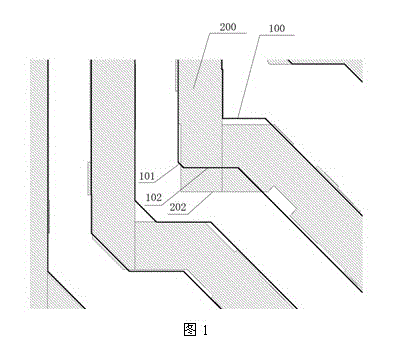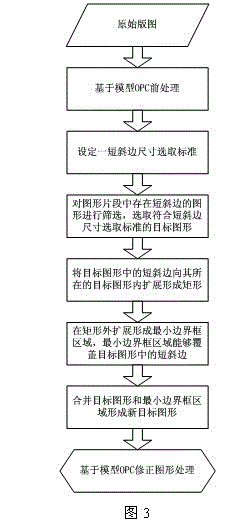Graph pretreatment method for removing negative OPC (Optical Proximity Correction)
A preprocessing and graphic technology, applied in the photomechanical process of photomechanical processing of originals, pattern surface, optics, etc., can solve the problem of short bevel graphic preprocessing etc.
- Summary
- Abstract
- Description
- Claims
- Application Information
AI Technical Summary
Problems solved by technology
Method used
Image
Examples
Embodiment Construction
[0027] The present invention will be further described below with reference to the drawings and specific embodiments, but it is not a limitation of the present invention.
[0028] In the prior art, the original graphic 100 is directly subjected to model-based OPC processing to obtain a corrected graphic 200 with abnormal OPC correction results, such as figure 1 As shown, the horizontal edge 102 adjacent to the short hypotenuse 101 forms a corrected horizontal edge 202 farther from the target after correction. Simulate the correction graph 200, such as figure 2 As shown, due to the excessive correction, the distance between the simulated correction pattern 300 and the adjacent lower pattern at A is too small, forming a weak bridging phenomenon. When the process is unstable, bridging is likely to occur at weak points.
[0029] An embodiment of the present invention relates to a graphics preprocessing method for removing unfavorable OPC corrections, which is applied after the original...
PUM
 Login to View More
Login to View More Abstract
Description
Claims
Application Information
 Login to View More
Login to View More - R&D
- Intellectual Property
- Life Sciences
- Materials
- Tech Scout
- Unparalleled Data Quality
- Higher Quality Content
- 60% Fewer Hallucinations
Browse by: Latest US Patents, China's latest patents, Technical Efficacy Thesaurus, Application Domain, Technology Topic, Popular Technical Reports.
© 2025 PatSnap. All rights reserved.Legal|Privacy policy|Modern Slavery Act Transparency Statement|Sitemap|About US| Contact US: help@patsnap.com



